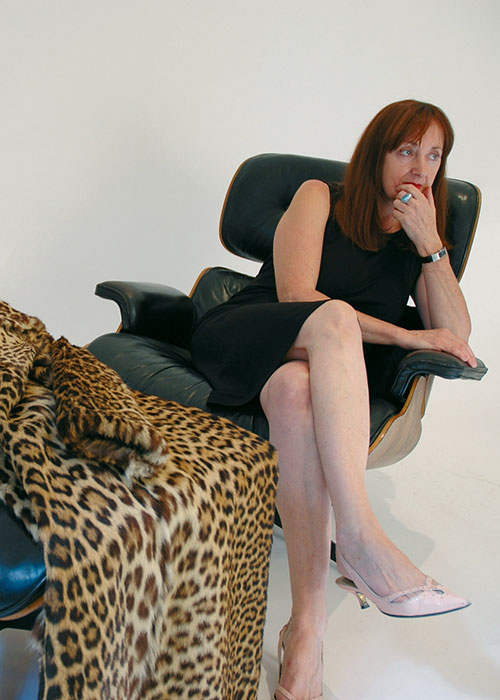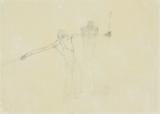A rare "Galaxy 2" couch table, designed by Walter Pichler,

1966, for R. Svoboda & Co, Austria, naturally anodised and satin polished aluminium sheet, bevelled glass top, 140 x 60 cm, height 41 cm.
Original condition. Not more than altogether ten "Galaxy" tables were produced - some in aluminium and some in steel.
The "Galaxy" design was first presented at the Vienna Museum of Applied Arts (MAK) in 1966 within the framework of the exhibition "Selection 66".
Lit.: Produktkatalog Galaxy 1, R. Svoboda & Co, Wien 5/1967/1011 - md. möbel interieur design, 10/1967/1017 - md. möbel interieur design, 2/1968/156 - Interview mit Walter Pichler, in: Umriss, 1/1985, S. 25-34 - G. Koller, Die Radikalisierung der Phantasie. Design aus Österreich, Salzburg 1987, pp. 211/12 - S. Breitwieser, Pichler. Prototypen 1966-69, Wien 1998, S. 173-181, S. 196/197 - Ch. Skrein, 68. künstler legenden fotografien, Wien 2001, Abb. S. 18/19, S. 122, S. 100/101.
Provenance: private ownership, Vienna.
Walter Pichler’s "Galaxy"
In its aesthetics and conceptual approach, Walter Pichler’s "Galaxy" design, which was inspired by space flight and the aircraft industry, goes far beyond the sixties’ space age: an unconventional piece of aluminium furniture, it seems to float above the floor, while the large holes in its perforated sides and back recall the lightweight constructions of aeroplanes and space rockets - even the rivets directly derive from aviation technology. For the joints of the frame and the rubber-supported suspension of the seats, the Citroën 2CV was referred to as a model.
In 1967, during the third edition of Jochen Rindt’s Racing Car Show, an annual display of the speediest cars of the previous season, Peter Noever, who had motivated the artist to tackle the project, and Walter Pichler himself presented their piece of furniture in a specially conceived stall. A mannequin holding a car bonnet on her lap was seated in the chair. Pichler commented upon the event: "We took a stall, just like the automobile manufacturers. We deliberately chose a context removed from art and galleries and presented the chair as if it were a racing car." The periodical md stated euphorically: "The soundscape consisted of ‘psychedelic music’ freshly imported from London and San Francisco. If racing cars could talk, they would report about their astonishment!"
Walter Pichler was then already a shooting star of the art scene. In 1967 he participated in the exhibition Visionary Architecture at New York’s Museum of Modern Art together with Hans Hollein and Raimund Abraham. The Futurist "Galaxy" model immediately caused a furore. It was also shown in the Austrian pavilion at Expo 67 in Montreal. Documenta 4 presented a selection of "prototypes", by which Pichler foresaw a world governed by media consumption.
Pichler would remain affiliated with architecture and architects throughout his life. In the eyes of the artist, who saw no boundaries between architecture and sculpture, the chair was a sculpture that could be sat on. It was tried out by a number of celebrities, such as by Alexey Leonov, the first man in space, who attended the space conference UNISPACE 1968 together with Arthur C. Clarke, the co-author of Stanley Kubrick’s science fiction film 2001: A Space Odyssey; or by "overpainter" Arnulf Rainer, who had himself photographed that same year with an expressively painted face while posing in the "Galaxy 1" for the cover of the catalogue accompanying his exhibition at the 20er Haus in Vienna.
additional pictures: Arnulf Rainer sitting in „Galaxy 1" (cat. cover Rainer, Museum des 20. Jahrhunderts, Vienna 1968)
Esperta: Dr. Gerti Draxler
 Dr. Gerti Draxler
Dr. Gerti Draxler
+43-1-515 60-226
gerti.draxler@dorotheum.at
20.05.2015 - 18:00
- Prezzo realizzato: **
-
EUR 18.750,-
- Stima:
-
EUR 15.000,- a EUR 20.000,-
A rare "Galaxy 2" couch table, designed by Walter Pichler,
1966, for R. Svoboda & Co, Austria, naturally anodised and satin polished aluminium sheet, bevelled glass top, 140 x 60 cm, height 41 cm.
Original condition. Not more than altogether ten "Galaxy" tables were produced - some in aluminium and some in steel.
The "Galaxy" design was first presented at the Vienna Museum of Applied Arts (MAK) in 1966 within the framework of the exhibition "Selection 66".
Lit.: Produktkatalog Galaxy 1, R. Svoboda & Co, Wien 5/1967/1011 - md. möbel interieur design, 10/1967/1017 - md. möbel interieur design, 2/1968/156 - Interview mit Walter Pichler, in: Umriss, 1/1985, S. 25-34 - G. Koller, Die Radikalisierung der Phantasie. Design aus Österreich, Salzburg 1987, pp. 211/12 - S. Breitwieser, Pichler. Prototypen 1966-69, Wien 1998, S. 173-181, S. 196/197 - Ch. Skrein, 68. künstler legenden fotografien, Wien 2001, Abb. S. 18/19, S. 122, S. 100/101.
Provenance: private ownership, Vienna.
Walter Pichler’s "Galaxy"
In its aesthetics and conceptual approach, Walter Pichler’s "Galaxy" design, which was inspired by space flight and the aircraft industry, goes far beyond the sixties’ space age: an unconventional piece of aluminium furniture, it seems to float above the floor, while the large holes in its perforated sides and back recall the lightweight constructions of aeroplanes and space rockets - even the rivets directly derive from aviation technology. For the joints of the frame and the rubber-supported suspension of the seats, the Citroën 2CV was referred to as a model.
In 1967, during the third edition of Jochen Rindt’s Racing Car Show, an annual display of the speediest cars of the previous season, Peter Noever, who had motivated the artist to tackle the project, and Walter Pichler himself presented their piece of furniture in a specially conceived stall. A mannequin holding a car bonnet on her lap was seated in the chair. Pichler commented upon the event: "We took a stall, just like the automobile manufacturers. We deliberately chose a context removed from art and galleries and presented the chair as if it were a racing car." The periodical md stated euphorically: "The soundscape consisted of ‘psychedelic music’ freshly imported from London and San Francisco. If racing cars could talk, they would report about their astonishment!"
Walter Pichler was then already a shooting star of the art scene. In 1967 he participated in the exhibition Visionary Architecture at New York’s Museum of Modern Art together with Hans Hollein and Raimund Abraham. The Futurist "Galaxy" model immediately caused a furore. It was also shown in the Austrian pavilion at Expo 67 in Montreal. Documenta 4 presented a selection of "prototypes", by which Pichler foresaw a world governed by media consumption.
Pichler would remain affiliated with architecture and architects throughout his life. In the eyes of the artist, who saw no boundaries between architecture and sculpture, the chair was a sculpture that could be sat on. It was tried out by a number of celebrities, such as by Alexey Leonov, the first man in space, who attended the space conference UNISPACE 1968 together with Arthur C. Clarke, the co-author of Stanley Kubrick’s science fiction film 2001: A Space Odyssey; or by "overpainter" Arnulf Rainer, who had himself photographed that same year with an expressively painted face while posing in the "Galaxy 1" for the cover of the catalogue accompanying his exhibition at the 20er Haus in Vienna.
additional pictures: Arnulf Rainer sitting in „Galaxy 1" (cat. cover Rainer, Museum des 20. Jahrhunderts, Vienna 1968)
Esperta: Dr. Gerti Draxler
 Dr. Gerti Draxler
Dr. Gerti Draxler
+43-1-515 60-226
gerti.draxler@dorotheum.at
|
Hotline dell'acquirente
lun-ven: 10.00 - 17.00
kundendienst@dorotheum.at +43 1 515 60 200 |
| Asta: | Design |
| Tipo d'asta: | Asta in sala |
| Data: | 20.05.2015 - 18:00 |
| Luogo dell'asta: | Wien | Palais Dorotheum |
| Esposizione: | 13.05. - 20.05.2015 |
** Prezzo d'acquisto comprensivo di tassa di vendita e IVA
Non è più possibile effettuare un ordine di acquisto su Internet. L'asta è in preparazione o è già stata eseguita.
Altri oggetti dell'artista
-

Stima:
EUR 2.500,- a EUR 4.500,-
